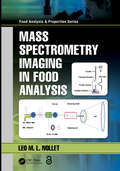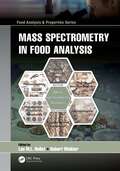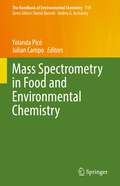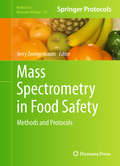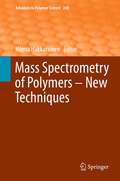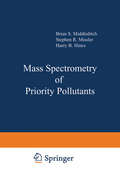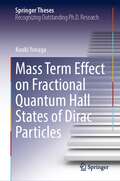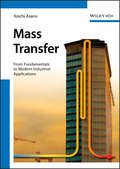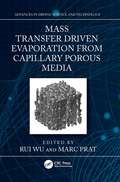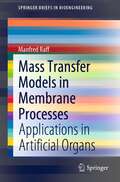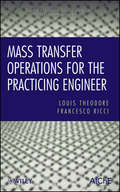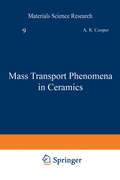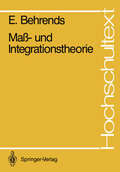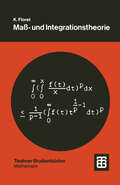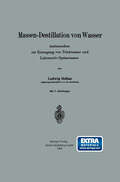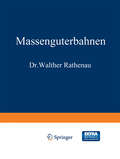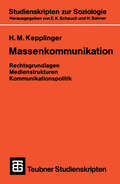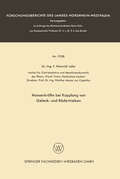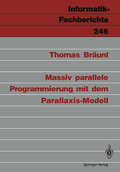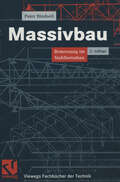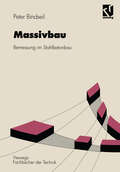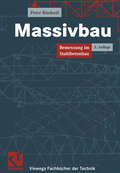- Table View
- List View
Mass Spectrometry Imaging in Food Analysis (Food Analysis & Properties)
by Leo M. L. NolletFood contains various compounds and many technologies exist to analyze those molecules of interest. However, the analysis of the spatial distribution of those compounds using conventional technology, such as liquid chromatography-mass spectrometry or gas chromatography-mass spectrometry is difficult. Mass spectrometry imaging (MSI) is a mass spectrometry technique to visualize the spatial distribution of molecules, as biomarkers, metabolites, peptides or proteins by their molecular masses. Despite the fact that MSI has been generally considered a qualitative method, the signal generated by this technique is proportional to the relative abundance of the analyte and so quantification is possible. Mass Spectrometry Imaging in Food Analysis, a volume in the Food Analysis and Properties Series, explains how the novel use of matrix-assisted laser desorption/ionization mass spectrometry imaging (MALDI-MSI) will be an ideal complementary approach. MALDI-MSI is a two-dimensional MALDI-MS technology that can detect compounds in a tissue section without extraction, purification, separation, or labeling. It can be used to visualize the spatial distribution of biomolecules in foods. Features: Explains the novel use of matrix-assisted laser desorption/ionization mass spectrometry imaging in food analysis Describes how MALDI-MSI will be a useful technique for optical quality assurance. Shows how MALDI-MSI detects food contaminants and residues Covers the historical development of the technology While there are a multitude of books on mass spectrometry, none focus on food applications and thus this book is ideally suited to food scientists, food industry personnel engaged in product development, research institutions, and universities active in food analysis or chemical analysis. Also available in the Food Analysis and Properties Series: Food Aroma Evolution: During Food Processing, Cooking, and Aging, edited by Matteo Bordiga and Leo M.L. Nollet (ISBN: 9781138338241) Ambient Mass Spectroscopy Techniques in Food and the Environment, edited by Leo M.L. Nollet and Basil K. Munjanja (ISBN: 9781138505568) Hyperspectral Imaging Analysis and Applications for Food Quality, edited by N.C. Basantia, Leo M.L. Nollet, and Mohammed Kamruzzaman (ISBN: 9781138630796) For a complete list of books in this series, please visit our website at: www.crcpress.com/Food-Analysis--Properties/book-series/CRCFOODANPRO
Mass Spectrometry in Food Analysis (Food Analysis & Properties)
by Leo M.L. NolletThe quality and safety of food are crucial for human nutrition. However, evaluating the chemical composition of food is challenging for the analyst and requires powerful methods. Chromatography and mass spectrometry (MS) is the gold standard for analyzing complex food samples, including raw materials and intermediate and finished products. Mass Spectrometry in Food Analysis covers the MS-based analysis of different aspects of food quality, which include nutritional value, profile of macronutrients (proteins, lipids, and carbohydrates), micronutrients (vitamins), and nutraceutical active compounds. Additionally, sensory quality, flavor, food pigments, safety, and detection of pesticides, contact materials, veterinary drugs and pharmaceuticals, organic pollutants, and pathogens are covered. Key Features: Contains the basics of mass spectrometry and experimental strategies Explores determination of macro- and micronutrients Analyzes sensory and nutraceutical food quality Discusses detection of contaminants and proof of authenticity Presents emerging methods for food analysis This book contains an introductory section that explains the basics of MS and the difference between targeted and untargeted strategies for beginners. Further, it points out new analytical challenges, such as monitoring contaminants of emerging concern, and presents innovative techniques (e.g., ambient ionization MS and data mining). Also available in the Food Analysis & Properties Series: Nanoemulsions in Food Technology: Development, Characterization, and Applications, edited by Javed Ahmad and Leo M.L. Nollet (ISBN: 978-0-367-61492-8) Sequencing Technologies in Microbial Food Safety and Quality, edited by Devarajan Thangadurai, Leo M.L. Nollet, Saher Islam, and Jeyabalan Sangeetha (ISBN: 978-0-367-35118-2) Chiral Organic Pollutants: Monitoring and Characterization in Food and the Environment, edited by Edmond Sanganyado, Basil K. Munjanja, and Leo M.L. Nollet (ISBN: 978-0-367-42923-2) For a complete list of books in this series, please visit our website at: www.crcpress.com/Food-Analysis--Properties/book-series/CRCFOODANPRO
Mass Spectrometry in Food Analysis (Food Analysis & Properties)
by Leo M. L. Nollet Robert WinklerThe quality and safety of food are crucial for human nutrition. However, evaluating the chemical composition of food is challenging for the analyst and requires powerful methods. Chromatography and mass spectrometry (MS) is the gold standard for analyzing complex food samples, including raw materials and intermediate and finished products. Mass Spectrometry in Food Analysis covers the MS-based analysis of different aspects of food quality, which include nutritional value, profile of macronutrients (proteins, lipids, and carbohydrates), micronutrients (vitamins), and nutraceutical active compounds. Additionally, sensory quality, flavor, food pigments, safety, and detection of pesticides, contact materials, veterinary drugs and pharmaceuticals, organic pollutants, and pathogens are covered. Key Features: Contains the basics of mass spectrometry and experimental strategies Explores determination of macro- and micronutrients Analyzes sensory and nutraceutical food quality Discusses detection of contaminants and proof of authenticity Presents emerging methods for food analysis This book contains an introductory section that explains the basics of MS and the difference between targeted and untargeted strategies for beginners. Further, it points out new analytical challenges, such as monitoring contaminants of emerging concern, and presents innovative techniques (e.g., ambient ionization MS and data mining). Also available in the Food Analysis & Properties Series: Nanoemulsions in Food Technology: Development, Characterization, and Applications, edited by Javed Ahmad and Leo M.L. Nollet (ISBN: 978-0-367-61492-8) Sequencing Technologies in Microbial Food Safety and Quality, edited by Devarajan Thangadurai, Leo M.L. Nollet, Saher Islam, and Jeyabalan Sangeetha (ISBN: 978-0-367-35118-2) Chiral Organic Pollutants: Monitoring and Characterization in Food and the Environment, edited by Edmond Sanganyado, Basil K. Munjanja, and Leo M.L. Nollet (ISBN: 978-0-367-42923-2) For a complete list of books in this series, please visit our website at: www.crcpress.com/Food-Analysis--Properties/book-series/CRCFOODANPRO
Mass Spectrometry in Food and Environmental Chemistry (The Handbook of Environmental Chemistry #119)
by Yolanda Picó Julian CampoThis book reviews the latest advances in mass spectrometry (MS) techniques applied to food safety and environment quality, and it discusses the recent improvements in sample preparation and MS platforms for screening of emerging contaminants. Expert contributors discuss the current applications from omics to the screening of emerging contaminants and nanomaterials in food and environmental matrices, and particular attention is given to the opportunities that MS offers for guarantying food security and promoting the sustainable use of ecosystems. Divided into 13 chapters, the book covers topics such as the handling and preparation of food and environmental samples for MS, foodomics, environmental omics, ambient ionization techniques in food and environmental chemistry, and chip-based separation devices coupled to MS. Readers will also find a comprehensive overview of several MS techniques applied to food and environmental chemistry, including elemental, isotopic, chiral, ion mobility, chromatographic and imaging MS. This book will appeal not only to students and researchers, but also to professionals working with MS platforms in food safety and environmental quality. The different advances and promising applications described in this work will be of paramount importance for ensuring food safety and environment health for current and future generations.
Mass Spectrometry in Food Safety: Methods and Protocols (Methods in Molecular Biology #747)
by Jerry ZweigenbaumAs a key component of human survival, a safe and sufficient food supply is essential for a healthy and productive population throughout the world, so assurance that the food supply is clean and free of harmful substances is a global concern. In Mass Spectrometry in Food Safety: Methods and Protocols, experts in the field provide context to the subject through reviews of regulations in various countries, the current state-of-the art, and specific, detailed scientific methods being employed today. The volume thoroughly covers the key areas in food safety, such as detection of low level chemical residues, pesticide analysis aided by chromatographic techniques, and the revealing of mycotoxins and chemical contaminants from packaging materials. Written in the highly successful Methods in Molecular Biology™ series format, method chapters contain introductions to their respective topics, lists of the necessary materials and reagents, step-by-step, readily reproducible laboratory protocols, and tips on troubleshooting and avoiding known pitfalls. Pertinent and cutting-edge, Mass Spectrometry in Food Safety: Methods and Protocols serves researchers with both understanding and appreciation for the contribution of mass spectrometry and its vital application to food testing and food safety.
Mass Spectrometry of Polymers – New Techniques (Advances in Polymer Science #248)
by Minna HakkarainenEmerging Mass Spectrometric Tools for Analysis of Polymers and Polymer Additives, by Nina Aminlashgari and Minna Hakkarainen. Analysis of Polymer Additives and Impurities by Liquid Chromatography/Mass Spectrometry and Capillary Electrophoresis/Mass Spectrometry, by Wolfgang Buchberger and Martin Stiftinger. Direct Insertion Probe Mass Spectrometry of Polymers, by Jale Hacaloglu Mass Spectrometric Characterization of Oligo- and Polysaccharides and Their Derivatives, by Petra Mischnick. Electrospray Ionization-Mass Spectrometry for Molecular Level Understanding of Polymer Degradation, by Minna Hakkarainen.
Mass Spectrometry of Priority Pollutants
by Brian MiddleditchWhen the list of organic priority pollutants was first published, many mass spec troscopists went scrambling to their reference books. GC-MS was mandated for the analysis of 114 compounds, yet the spectra of many of them, if they had been recorded at all, were scattered throughout the literature. Moreover, it soon became apparent that, even if a sufficient number of instruments could be made available to undertake the task of monitoring 114 substances in the effluents of 21 categories of industry, the personnel could not be trained to perform the analyses and interpret the results. The solution to this problem has been the development of highly automated mass spectrometers which can be operated by personnel without the traditional research training. This book is for the new breed of mass spectroscopist who is not interested in the esoteric details of mass spectral fragmentation, but who merely wishes to identify specific pollutants in effluents. Our inclusion of com prehensive lists of synonyms and bibliographic data should make the book of even greater value to the reader who is not too familiar with the idiosyncrasies of chemical nomenclature and the scientific literature. The experienced mass spectroscopist should also benefit from having all of the data collected together in one volume. This is a book to be used, rather than deposited in a library distant from the laboratory: we would hope that it will fmd a place on top of every mass spectrometer used for the analysis of priority pollutants.
Mass Term Effect on Fractional Quantum Hall States of Dirac Particles (Springer Theses)
by Kouki YonagaThis book presents the high-precision analysis of ground states and low-energy excitations in fractional quantum Hall states formed by Dirac electrons, which have attracted a great deal of attention. In particular the author focuses on the physics of fractional quantum Hall states in graphene on a hexagonal boron nitride substrate, which was recently implemented in experiments. The numerical approach employed in the book, which uses an exact numerical diagonalization of an effective model Hamiltonian on a Haldane’s sphere based on pseudopotential representation of electron interaction, provides a better understanding of the recent experiments. The book reviews various aspects of quantum Hall effect: a brief history, recent experiments with graphene, and fundamental theories on integer and fractional Hall effects. It allows readers to quickly grasp the physics of quantum Hall states of Dirac fermions, and to catch up on latest research on the quantum Hall effect in graphene.
Mass Transfer: From Fundamentals to Modern Industrial Applications
by Koichi AsanoThis didactic approach to the principles and modeling of mass transfer as it is needed in modern industrial processes is unique in combining a step-by-step introduction to all important fundamentals with the most recent applications. Based upon the renowned author's successful new modeling method as used for the O-18 process, the exemplary exercises included in the text are fact-proven, taken directly from existing chemical plants. Fascinating reading for chemists, graduate students, chemical and process engineers, as well as thermodynamics physicists.
Mass Transfer Driven Evaporation From Capillary Porous Media (Advances in Drying Science and Technology)
by Marc Prat Rui WuMass Transfer–Driven Evaporation from Capillary Porous Media offers a comprehensive review of mass transfer–driven drying processes in capillary porous media, including pore-scale and macro-scale experiments and models. It covers kinetics of drying of a single pore, pore-scale experiments and models, macro-scale experiments and models, and understanding of the continuum model from pore-scale studies. The book: Explains the detailed transport processes in porous media during drying. Introduces cutting-edge visualization experiments of drying in porous media. Describes the pore network models of drying in porous media. Discusses the continuum models of drying in porous media based on pore-scale studies. Points out future research opportunities. Aimed at researchers, students and practicing engineers, this work provides vital fundamental and applied information to those working in drying technology, food processes, applied energy, and mechanical and chemical engineering.
Mass Transfer Driven Evaporation From Capillary Porous Media (Advances in Drying Science and Technology)
by Rui WuMass Transfer–Driven Evaporation from Capillary Porous Media offers a comprehensive review of mass transfer–driven drying processes in capillary porous media, including pore-scale and macro-scale experiments and models. It covers kinetics of drying of a single pore, pore-scale experiments and models, macro-scale experiments and models, and understanding of the continuum model from pore-scale studies. The book: Explains the detailed transport processes in porous media during drying. Introduces cutting-edge visualization experiments of drying in porous media. Describes the pore network models of drying in porous media. Discusses the continuum models of drying in porous media based on pore-scale studies. Points out future research opportunities. Aimed at researchers, students and practicing engineers, this work provides vital fundamental and applied information to those working in drying technology, food processes, applied energy, and mechanical and chemical engineering.
Mass Transfer Models in Membrane Processes: Applications in Artificial Organs (SpringerBriefs in Bioengineering)
by Manfred RaffThis book serves as an introduction on mass transfer models in membrane processes, with a special focus on their applications in Artificial Organs. Various such models are discussed while multiple easy to use module equations are presented, enabling readers to gain basic knowledge of the mass flow of toxins across membranes. This is particularly interesting to membrane manufacturers who may use these equations to improve the relation of module performances and production costs. Additionally, examples which specialize on artificial organs, but in principle can be applied to analogous environmental, food and biotechnology processes- are analysed. This book will appeal to readers who want to understand how membrane modules and processes can be optimized and will be a great tool for graduates, researchers and professionals working in this field.
Mass Transfer Operations for the Practicing Engineer (Essential Engineering Calculations Series #8)
by Louis Theodore Francesco RicciAn invaluable guide for problem solving in mass transfer operations This book takes a highly pragmatic approach to providing the principles and applications of mass transfer operations by offering a valuable, easily accessible guide to solving engineering problems. Both traditional and novel mass transfer processes receive treatment. As with all of the books in this series, emphasis is placed on an example-based approach to illustrating key engineering concepts. The book is divided into two major parts. It starts with the principles underlying engineering problems—showing readers how to apply general engineering principles to the topic of mass transfer operations. It then goes on to provide step-by-step guidance for traditional mass transfer operations, including distillation, absorption and stripping, and adsorption, plus novel mass transfer processes. Essential topics for professional engineering exams are also covered. Geared towards chemical, environmental, civil, and mechanical engineers working on real-world industrial applications, Mass Transfer Operations for the Practicing Engineer features: Numerous sample problems and solutions with real-world applications Clear, precise explanations on how to carry out the basic calculations associated with mass transfer operations Coverage of topics from the ground up for readers without prior knowledge of the subject Overview of topics relevant to the ABET (Accreditation Board for Engineering and Technology) for those taking the Professional Engineering (PE) exams Appendix containing relevant mass transfer operation charts and tables
Mass Transfer Operations for the Practicing Engineer (Essential Engineering Calculations Series #3)
by Louis Theodore Francesco RicciAn invaluable guide for problem solving in mass transfer operations This book takes a highly pragmatic approach to providing the principles and applications of mass transfer operations by offering a valuable, easily accessible guide to solving engineering problems. Both traditional and novel mass transfer processes receive treatment. As with all of the books in this series, emphasis is placed on an example-based approach to illustrating key engineering concepts. The book is divided into two major parts. It starts with the principles underlying engineering problems—showing readers how to apply general engineering principles to the topic of mass transfer operations. It then goes on to provide step-by-step guidance for traditional mass transfer operations, including distillation, absorption and stripping, and adsorption, plus novel mass transfer processes. Essential topics for professional engineering exams are also covered. Geared towards chemical, environmental, civil, and mechanical engineers working on real-world industrial applications, Mass Transfer Operations for the Practicing Engineer features: Numerous sample problems and solutions with real-world applications Clear, precise explanations on how to carry out the basic calculations associated with mass transfer operations Coverage of topics from the ground up for readers without prior knowledge of the subject Overview of topics relevant to the ABET (Accreditation Board for Engineering and Technology) for those taking the Professional Engineering (PE) exams Appendix containing relevant mass transfer operation charts and tables
Massen-Destillation von Wasser insbesondere zur Erzeugung von Trinkwasser und Lokomotiv-Speisewasser
by Ludwig BothasMassenkommunikation: Rechtsgrundlagen, Medienstrukturen, Kommunikationspolitik (Teubner Studienskripten zur Soziologie #43)
by Hans Mathias KepplingerMassenkräfte bei Kopplung von Gelenk- und Rädertrieben (Forschungsberichte des Landes Nordrhein-Westfalen #1958)
by Franz Heinrich LehnMassiv parallele Programmierung mit dem Parallaxis-Modell (Informatik-Fachberichte #246)
by Thomas BräunlMassivbau: Bemessung im Stahlbetonbau (Viewegs Fachbücher der Technik)
by Peter BindseilAuch in der 2., überarbeiteten Auflage werden die Grundlagen des Stahlbetonbaus einfach und verständlich erklärt. Die zahlreichen Beispiele, denen der Eurocode 2 zu Grunde liegt, machen die dargestellte Theorie nachvollziehbar. Im Anhang wird ein Ausblick auf DIN 1045-1 gegeben, die den Eurocode 2 und die DIN 1045 Ausgabe 1988 ablösen wird.
Massivbau: Bemessung im Stahlbetonbau (Viewegs Fachbücher der Technik)
by Peter BindseilDieses Buch behandelt den Stahlbetonbau auf der Basis der neuen Sicherheits- und Bemessungskonzepte, wie sie derzeit im Eurocode EC 2 formuliert sind. Im Anhang wird ein Ausblick auf die geplante DIN 1045-1 gegeben.Der umfangreiche Stoff wird in einem Band als Lehrbuch vorgestellt, um Grundlagen und Berechnungsmethoden direkt durch Beispiele vertiefen zu können.Teil A: Sicherheitstheorie, Grundlagen der Bauweise, Bemessung stabförmiger Biegetragwerke, konstruktive GrundsätzeTeil B: Globale und lokale Stabilität von Bauwerken und Bauteilen (Räumliche Steifigkeit und Stabiliät, druckbeanspruchte Stäbe, Kippen)Teil C: Fundamente, Rahmen, Konsolen, zweiachsig gespannte Platten, Flachdecken, kurze Einführung in die Berechnung von Flächentragwerken mit Finiten Elementen
Massivbau: Bemessung im Stahlbetonbau (Viewegs Fachbücher der Technik)
by Peter BindseilDas bewährte Fachbuch jetzt mit der neuen DIN 1045-1! Die im Sommer 2001 neu erschienene DIN 1045-1 hat die vollständige Überarbeitung des bewährten Studienbuchs Massivbau erforderlich gemacht. Nunmehr in der 3. Auflage wird das Thema des Stahlbetonbaus verständlich und nachvollziehbar dargestellt. Durch die Gliederung in 3 Teile wird trotz des Stoffumfangs die erforderliche Übersichtlichkeit gewährleistet. Wie auch in den Vorauflagen erleichtert das ausgewogene Verhältnis zwischen theoretischen Grundlagen und Berechnungsbeispielen die Einarbeitung in die umfangreiche Problematik des Stahlbetonbaus.
